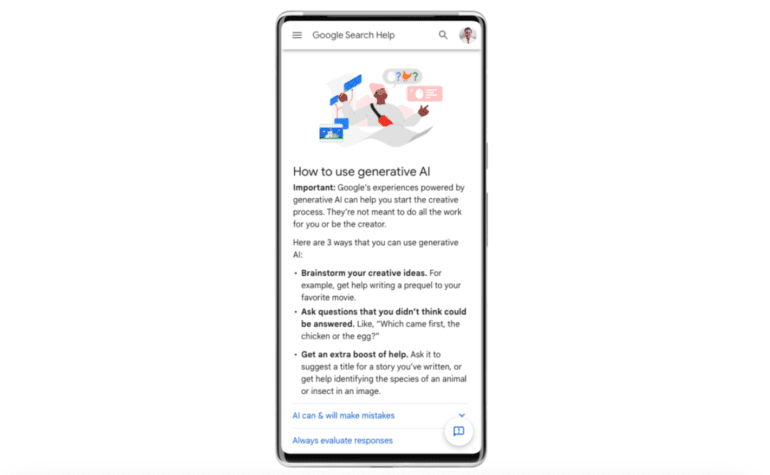TL;DR:
- Google extends its generative AI search, called SGE, to teenagers aged 13-17 in the US.
- SGE introduces conversational search, allowing users to interact with Google in a more dialogic manner.
- Safety measures are in place to prevent inappropriate content, aligning with teenage developmental needs.
- Google introduces an “About this result” notice to offer context on how SGE generates responses.
- Plans to enhance the notice for individual links within SGE responses are in the pipeline.
- Google is focused on improving responses to queries with false or offensive premises.
- It plans to use large language models to critique and refine responses on sensitive topics.
- The expansion to teenagers aligns with SGE’s popularity among younger users aged 18-24.
- Google continues to innovate the AI search experience, with support for multimedia, local info, and more.
- The company experiments with ads alongside AI-generated responses.
Main AI News:
In the realm of AI-driven exploration, Google, a pioneering force, is extending its generative AI search capabilities to a younger demographic. This strategic move, unveiled by the tech giant on a recent Thursday, is set to empower teenagers with newfound search prowess. Google is not only rolling out this feature but also bolstering it with an innovative context-enhancing element, while simultaneously fortifying its AI model to thwart false and offensive inquiries.
Termed the “Search Generative Experience” or SGE, this AI-powered search journey takes Google Search to a new conversational horizon. Now, users can engage with Google in a more interactive, question-and-answer format, facilitating a deeper exploration of various topics.
This week marks the inauguration of a significant development; teenagers aged 13-17 in the United States, logged into their Google Accounts, gained access to the Search Labs. These labs serve as the gateway to the AI search experience, accessible through the Google app or Chrome desktop.
Hema Budaraju, Senior Director of Product Management at Google, highlighted the profound potential of generative AI for young minds. She expressed, “Generative AI can help younger people ask questions they couldn’t typically get answered by a search engine and pose follow-up questions to help them dig deeper.”
However, Google is acutely aware of the need to maintain a delicate equilibrium between expanding horizons and ensuring safety. Informed by research and expert guidance in teen development, the company has erected robust guardrails to prevent the surfacing of inappropriate or harmful content. Stronger protections are in place to safeguard against content relating to illegal substances, age-restricted materials, or bullying.
Google’s outreach to teenagers aligns with a fascinating observation. Since the inception of SGE, younger users have shown a keen affinity for the conversational search mode. Notably, individuals aged 18-24 have exhibited the highest satisfaction scores, preferring to interact with technology in a more dialogic manner.
Beyond this demographic expansion, Google is introducing an enlightening feature – the “About this result” notice. This function, already a fixture in standard Google Search, imparts vital context about how SGE generated a particular response. Users can gain insight into the inner workings of this technological marvel.
Furthermore, Google is set to enhance the “About this result” feature, extending it to the individual links embedded within SGE responses. This augmentation will allow users to delve deeper into the web pages supporting the AI-powered insights, promoting a more comprehensive understanding.
Google’s commitment to refining the AI search experience is evident. A notable focus lies in addressing queries founded on false or offensive premises. Such inquiries can lead to AI-generated responses inadvertently validating misinformation. To rectify this, Google is deploying an update to bolster the AI model’s ability to discern and respond effectively to such queries, prioritizing accuracy and quality.
Intriguingly, Google is also exploring the deployment of large language models to evaluate and refine their initial responses, particularly on sensitive subjects. This introspective approach aims to align responses with stringent quality and safety standards.
In recent months, Google has embarked on an enriching journey to augment the AI search experience. This voyage has encompassed support for multimedia content, local information, and travel recommendations, complemented by tools for summarization and definition. Additionally, the company has ventured into experimenting with advertisements alongside AI-generated responses, further underlining its commitment to innovation in the realm of search.
Conclusion:
Google’s expansion of generative AI search to teenagers signifies a strategic move to empower a younger demographic with interactive, conversational search capabilities. This move, coupled with enhanced safety measures and context provision, underlines Google’s commitment to a safer and more informative digital landscape. It also aligns with the growing preference for conversational search among younger users and showcases Google’s ongoing innovation in the search market.

